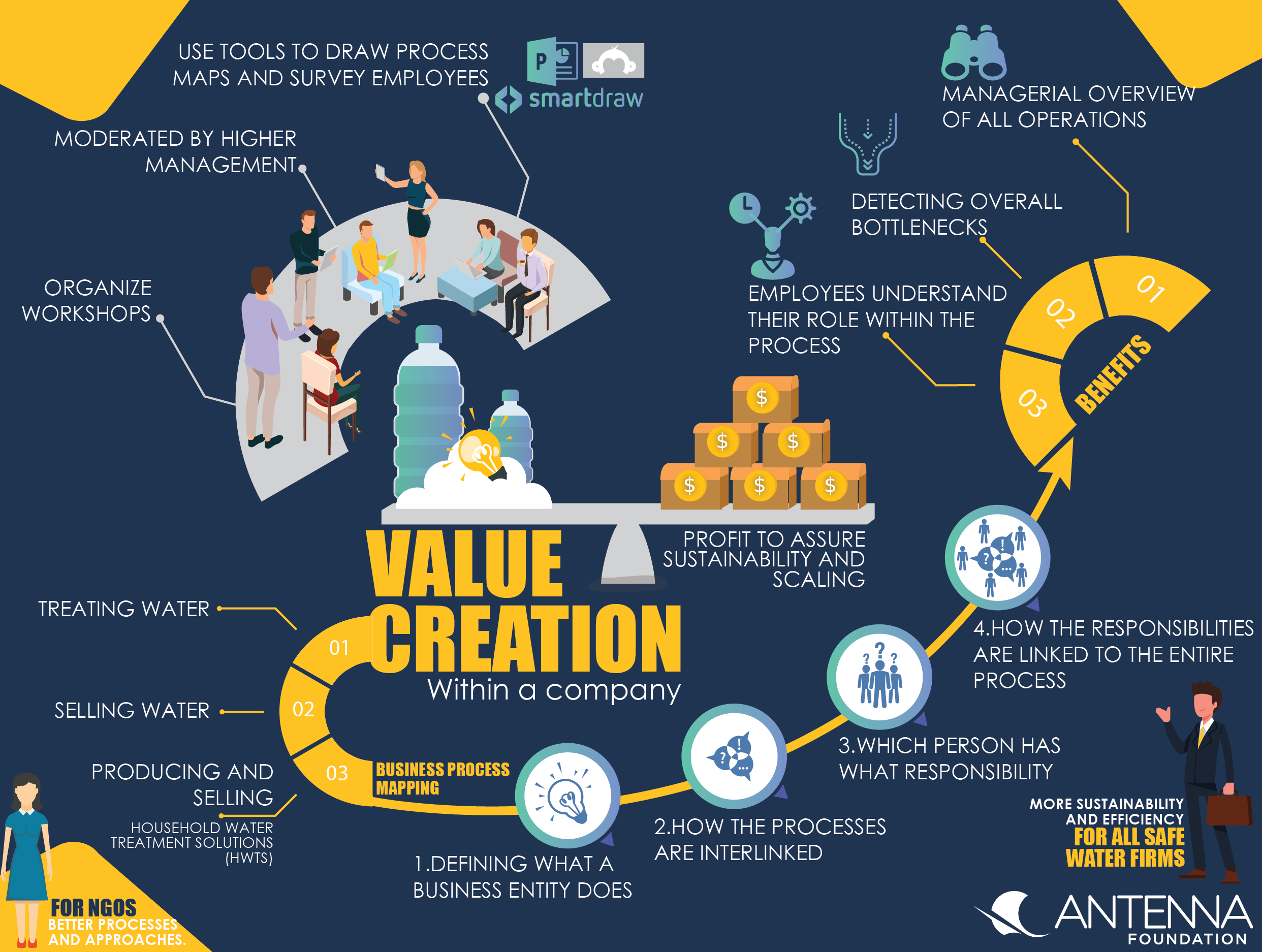Executive Summary

Value creation is the question of how to create value for your customers while creating a sustainable business case.
This factsheet focuses in particular on process mapping to help a safe water company identify the value that is created within the company’s processes and will help your business generate even more value for customers and the company itself.
The case study of how Spring Health has analysed its business via process mapping provides practical insights of how value creation can be implemented and tracked in practice.
What is value creation and why is it crucial to safe water businesses?
Value creation is incremental to every safe water business model. In order to deliver on a value proposition to customers, safe water firms require different resources, processes and capabilities (e.g. MORRIS ET AL., 2005), which in turn can be referred to as value chains or the way value is created on the side of the firm. Firms create value for their customers/users and capture some of it financially. The purpose of every safe water business is to create value through its activities, be it treating and selling water or producing and selling household water treatment solutions (HWTS), while capturing some of that value as profit to assure sustainability and possibilities for scaling safe water business activities.
A main concern for businesses is to not only secure resources and capabilities to create value, but also to implement and optimize processes to increase efficiency and reduce unnecessary costs.
But how can this value be created within your business?
For whom is value creation interesting?
Value creation is key for every safe water company to increase sustainability of the company and reach customers more efficiently. It also provides NGOs insights on how to better develop processes and design market based safe water approaches.
How can value creation be improved?
Multiple methods have been developed to aid firms in improving its value creation. A very helpful method is mapping the processes of value creation within a safe water enterprise. Examples of value mapping methods are the six sigma by SixSigma (Editor) (2018) or the water value creation tool by the Boston Consulting Group (BOSTON CONSULTING GROUP, 2018). These methods assess the processes of how value is created in a business to then identify how value can be efficiently increased.
Processes in a safe water project are identified as:
- Defining what a business entity does
- How the processes are interlinked
- Which person has what responsibility
- How the responsibilities are linked to the entire process of the safe water enterprise
Following this process, the value identified can be mapped in a cross-functional process map.
The business process mapping helps to:
- Gaining managerial overview of all operations within a safe water enterprise
- Detecting overall bottlenecks (e.g. HWTS production and product development, marketing, last mile distribution etc.)
- Communicating best practices and routines among employees. Thereby employees can more easily comprehend the entire process and routine landscape and their specific role within it (e.g. social marketing is linked to commercial marketing activities, collaboration of sales team and product development to include customer feedback on HWTS).
The example cross-functional process map below shows a generic example of how a company’s process can be mapped throughout functions. Additionally lower-level mappings can be added to help visualize the individual processes of business functions (e.g. safe water sales process, chlorine production process), or even for structuring tasks within teams.
To make this example more tangible, the graph below shows the process mapping of Tara’s Aqua+ production. Due to the mapping TARA was able to identify bottlenecks in the production (such as to keep stock of flasks, salt and define responsibilities). This mapping helped to calculate exact cost of production and forecast time needed to cater products to customers in time.
Realising value mapping in practice
There is no standard way of mapping a business processes. It helps however to organize workshops with your employees across all functions and hierarchies to:
- Provide input about the current procedures and potential improvements
- Provide insights on routines, and overall processes and ideas for improvements
Such gatherings are best moderated by higher management, or externals who can lead the session and mediate between different functions, hierarchies, or opinions. The identified process-steps can then be mapped as shown in the first graph. A simple tool for drawing a process map can be PowerPoint program or under SmartDraw Process Mapping Software.
In order to mitigate hurdles of addressing potential problems, surveys could be distributed among employees to anonymously provide feedback on processes and perceived problems. Online tools to perform such surveys are for example survey monkey or mopinion.
These measures will help identify process interfaces and bottlenecks in processes, and discuss potential solutions in order to increase value within a safe water company.
The Case Study on Value Creation within Spring Health will provide you with further insights on how a safe water enterprise has addressed value creation and process mapping.
Subscribe here to the new Sanitation and Water Entrepreneurship Pact (SWEP) newsletter. SWEP is a network of organizations joining hands to help entrepreneurs design and develop lasting water and sanitation businesses.
The Business of Water
Water Value Creation Tool
What Value Creation Will Look Like in the Future
Process Mapping: How to Reengineer your Business Processes
Hunt draws upon the experiences of companies around the world whose process mapping success stories will be a source of inspiration and instruction. You'll find out just how process mapping was put to use--and the results it achieved--at General Electric, IBM, NASA, Tandy Electronics, Shawmut National Bank, Fluor Daniel, Exxon, and other leading product and service firms.
HUNT, D. (1996): Process Mapping: How to Reengineer your Business Processes. Hoboken: John Wiley & Sons. URL [Accessed: 20.02.2018]Value Creation is the Foundation of Business
Introduction to Value Creation in Business
The entrepreneur's business model: toward a unified perspective
The six sigma way: How GE, Motorola, and other top companies are honing their performance
Process Improvement: A Handbook for Managers
Corporate-NGO Collaboration: Co-creating New Business Models for Developing Markets
Practical Guide to Creating Better Looking Process Maps
The role of social value creation in business model formulation at the bottom of the pyramid – Implications for MNEs?
The paper shows how social value creation and business models are interrelated in the context of the bottom of the pyramid (BOP) business formation. Ideas are discussed how constraints can be overcome and what economic and social outcomes can be achieved.
This is an open access article under Attribution 3.0 Unported (CC BY 3.0) License
SINKOVICS et al. (2014): The role of social value creation in business model formulation at the bottom of the pyramid – Implications for MNEs? . In: International Business Review: Volume 23 Issue 4, 692–707. URL [Accessed: 20.02.2018] PDF

